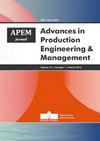带时间窗的时变双目标车辆路径问题
IF 2.8
3区 工程技术
Q2 ENGINEERING, MANUFACTURING
引用次数: 46
摘要
双目标车辆路径优化问题已成为近年来的研究热点。本文提出了一种具有时间窗的时变双目标车辆路径问题(TD-BO-VRPTW),它是经典车辆路径问题的新扩展。当车辆的行驶速度受其出发时间和两个顾客之间的距离的影响时,提出了时间依赖性。通过构建双目标混合整数线性规划模型,将总运输成本和时间成本作为两个目标同时优化。针对该问题,采用非支配排序遗传算法II (NSGA-II)求解Pareto最优解集。在数值算例中,采用了Solomon的基准集RC108,在Pareto前的结果显示了NSGA-II对TD-BO-VRPTW的效率。为了进一步测试该算法的性能,分别对两个目标进行优化,然后对两个目标的和进行优化。通过将这些结果与Pareto front的解进行比较,可以得出算法是可靠的,Pareto front的结果是竞争性的,因为两个目标之间存在权衡。本文章由计算机程序翻译,如有差异,请以英文原文为准。
Time-dependent and bi-objective vehicle routing problem with time windows
The optimization of bi-objective vehicle routing problem has become a research hotspot in recent years. In this paper, a time-dependent and bi-objective vehicle routing problem with time windows (TD-BO-VRPTW) is proposed, which is a new extension of classical vehicle routing problem. Time-dependency is presented for the situation that vehicle’s travel speed is affected by its departure time and the distance between two customers. The total transportation costs and time costs are two objectives optimized simultaneously through constructing a bi-objective mixed integer linear programming model. To deal with this problem, the non-dominated sorting genetic algorithm II (NSGA-II) is adopted to obtain the Pareto optimal solution set. In the numerical examples, the RC108 from Solomon's benchmark set is employed and the results in the Pareto front show the efficiency of NSGA-II for the TD-BO-VRPTW. To further test the performance of this algorithm, two objectives are optimized separately and then the sum of two objectives is also optimized. Through comparing these results with solutions in the Pareto front, it can be concluded that the algorithm is reliable, and the results in Pareto front are competitive because there is a trade-off between two objectives.
求助全文
通过发布文献求助,成功后即可免费获取论文全文。
去求助
来源期刊

Advances in Production Engineering & Management
ENGINEERING, MANUFACTURINGMATERIALS SCIENC-MATERIALS SCIENCE, MULTIDISCIPLINARY
CiteScore
5.90
自引率
22.20%
发文量
19
期刊介绍:
Advances in Production Engineering & Management (APEM journal) is an interdisciplinary international academic journal published quarterly. The main goal of the APEM journal is to present original, high quality, theoretical and application-oriented research developments in all areas of production engineering and production management to a broad audience of academics and practitioners. In order to bridge the gap between theory and practice, applications based on advanced theory and case studies are particularly welcome. For theoretical papers, their originality and research contributions are the main factors in the evaluation process. General approaches, formalisms, algorithms or techniques should be illustrated with significant applications that demonstrate their applicability to real-world problems. Please note the APEM journal is not intended especially for studying problems in the finance, economics, business, and bank sectors even though the methodology in the paper is quality/project management oriented. Therefore, the papers should include a substantial level of engineering issues in the field of manufacturing engineering.
 求助内容:
求助内容: 应助结果提醒方式:
应助结果提醒方式:


